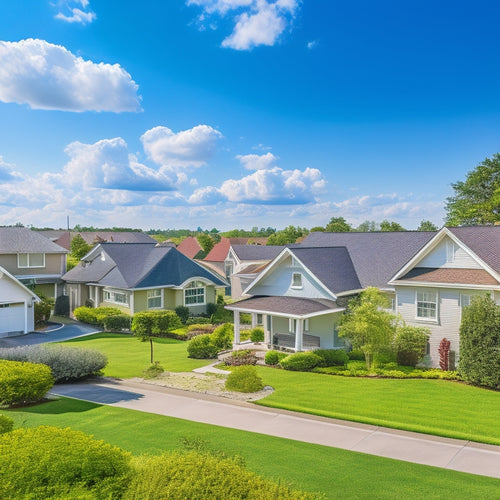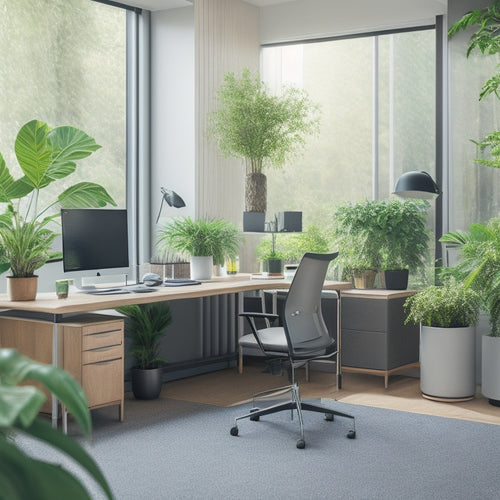
Innovative Bathroom Upgrades for Sustainable Living Enthusiasts
Share
You're upgrading your bathroom to reflect your commitment to sustainable living, and you're looking for innovative ways to reduce your environmental footprint while enhancing your space's functionality and aesthetic appeal. Consider swapping your traditional toilet for a composting one, which can conserve up to a third of your home's water usage. Or, investigate low-flow showerheads, grey water systems, and rainwater harvesting to further reduce your water waste. Eco-friendly materials like cork, bamboo, and reclaimed wood can also create a stylish and sustainable space. By incorporating these innovative upgrades, you'll not only shrink your carbon footprint but also uncover new ways to live more sustainably.
Key Takeaways
- Composting toilets and grey water systems significantly reduce water consumption and ecological footprint in bathrooms.
- Eco-friendly materials like cork, recycled tiles, and linoleum offer sustainable and durable options for bathroom flooring and vanities.
- Low-flow showerheads and fixtures conserve water and energy, while also providing a luxurious shower experience.
- Incorporating natural lighting design ideas, biophilic principles, and living walls creates a serene and calming bathroom atmosphere.
- Implementing waste management solutions, such as recycling bins and biodegradable products, encourages sustainable practices in bathrooms.
Composting Toilet Options
About one-third of your home's water usage is attributed to toilet flushing, which can be a significant burden on the environment. By switching to a composting toilet, you can reduce your water consumption and minimize your ecological footprint.
Additionally, incorporating renewable energy solutions, such as solar panels to power your home, can further reduce your reliance on fossil fuels. Composting toilet models, such as self-contained units and central composting systems, offer a water-free alternative to traditional toilets.
The benefits of composting toilets are numerous, including reduced water usage, lower energy consumption, and the production of nutrient-rich compost for your garden. You'll also enjoy lower water bills and a clear conscience, knowing you're doing your part for the planet.
With various composting toilet models available, you can find one that fits your needs and lifestyle, giving you the freedom to live more sustainably.
Water Conservation Strategies
Your sink, shower, and toilet are some of the thirstiest fixtures in your home, guzzling gallons of water with each use. To reduce your water footprint, consider these strategies:
- Low-flow fixtures: Install showerheads, faucets, and toilets that use considerably less water without sacrificing performance.
By leveraging fast charging infrastructure, we can reduce our reliance on traditional energy sources and conserve resources. Additionally, adopting sustainable practices in one area of our lives can have a ripple effect, inspiring us to make eco-friendly choices in other aspects of our daily routines.
-
Rainwater harvesting: Collect and store rainwater for non-potable uses like flushing toilets and washing clothes.
-
Drought-resistant landscaping: Choose plants that thrive in dry conditions, reducing the need for irrigation and preserving this precious resource.
Grey Water Systems Explained
Grey water systems are a clever way to reuse water from sinks, showers, and washing machines, reducing the amount of potable water needed for irrigation and flushing toilets.
By integrating renewable energy sources, such as solar power, into your grey water system, you can further reduce your carbon footprint and enhance energy independence.
Additionally, with the help of government incentives and tax credits, you can offset the costs of implementing a grey water system and other sustainable practices.
By installing a grey water system, you'll be able to collect and treat wastewater from your bathroom and laundry room, making it suitable for irrigation reuse.
This means you can water your garden, lawn, or indoor plants without wasting precious potable water.
Grey water filtration systems guarantee the water is clean and free of contaminants, making it safe for your plants.
With a grey water system, you'll not only conserve water but also reduce your water bill and your environmental footprint.
Low-Flow Showerhead Solutions
When you upgrade to a low-flow showerhead, you'll not only conserve water but also reduce your energy consumption.
By adopting renewable energy sources, such as solar energy, you can further minimize your carbon footprint.
Look for showerheads with built-in energy efficiency features, such as those that use advanced aerodynamics to create a satisfying shower experience while minimizing hot water usage.
With flow rate options as low as 1.5 gallons per minute, you can greatly reduce your water waste and lower your utility bills.
Water Conservation Methods
Take a step towards a more eco-friendly bathroom by swapping out your old showerhead for a low-flow alternative.
This simple switch can considerably reduce your water consumption, conserving this precious resource for future generations.
Additionally, considering the rising demand for electric vehicle charging infrastructure, it's crucial to investigate sustainable energy solutions that can support our daily lives while reducing our carbon footprint.
When it comes to water conservation methods, consider the following:
-
Rainwater Harvesting: Collect and store rainwater for non-potable uses like flushing toilets and washing clothes, reducing your reliance on municipal water supplies.
-
Dual-Flush Toilets: Install toilets with dual-flush capabilities, allowing you to choose between a full or partial flush, depending on your needs.
-
Eco-Friendly Plumbing: Opt for plumbing fixtures and pipes made from sustainable materials, reducing waste and minimizing environmental impact.
Energy Efficiency Features
You've already made a significant step towards a more eco-friendly bathroom by opting for a low-flow showerhead. Now, let's investigate other energy efficiency features to take your sustainable bathroom to the next level. Consider integrating smart home technology for energy monitoring and automated lighting to reduce energy waste.
| Energy Efficiency Feature | Description | Benefits |
|---|---|---|
| Solar Panels | Utilizes sunlight to generate electricity | Reduces reliance on non-renewable energy sources |
| Radiant Heating | Warms floors instead of air | Increases energy efficiency and comfort |
| Energy Efficient Appliances | Uses advanced technology to minimize energy consumption | Reduces energy bills and carbon footprint |
Flow Rate Options
As you investigate low-flow showerhead solutions, it's essential to understand the various flow rate options available, which directly impact your water conservation efforts.
You'll find that different flow rate technologies cater to unique needs and preferences.
-
Low-flow showerheads with flow rates of 1.5 gallons per minute (gpm) or less provide an effective way to reduce water consumption while maintaining a satisfying shower experience.
-
Faucet aerators, which mix water with air, can also reduce flow rates without sacrificing performance.
-
Variable flow rate showerheads allow you to adjust the flow rate according to your needs, providing flexibility and water-saving potential.
Sustainable Bathroom Flooring
Behind the shower curtain and beneath the vanity, your bathroom floor is a critical component of your sustainable bathroom redesign. When choosing an eco-friendly flooring option, consider cork flooring, a natural, soft, and warm material that's resistant to moisture and mold.
Recycled tiles are another great option, made from reclaimed materials like glass or ceramic. Linoleum options, made from natural linseed oil and wood flour, are durable and biodegradable.
If you prefer a softer option, look for sustainable carpets made from natural fibers like bamboo or coconut husk. These eco-friendly alternatives won't only reduce your environmental footprint but also create a comfortable and stylish bathroom space that reflects your values.
Eco-Friendly Vanity Materials
When choosing an eco-friendly vanity, you're considering materials that not only look great but also minimize environmental impact.
You'll want to investigate options like reclaimed wood, which gives new life to discarded materials, and bamboo vanity tops, a highly renewable resource.
Additionally, look for low-VOC (volatile organic compound) finishes to guarantee a healthier indoor environment.
Reclaimed Wood Options
How can you bring a touch of history and eco-friendliness to your bathroom? Consider incorporating reclaimed wood options into your eco-friendly vanity materials.
Reclaimed wood finishes not only add a unique aesthetic to your space but also reduce waste and preserve natural resources.
Here are three ways to incorporate reclaimed wood into your bathroom design:
- Salvaged barn wood for a rustic, country-inspired look.
- Reclaimed teak for a sleek, modern aesthetic.
- Upcycled pallet wood for a budget-friendly, DIY-friendly option.
When sourcing reclaimed wood, prioritize sustainable sourcing practices to guarantee the wood is harvested and processed responsibly.
Bamboo Vanity Tops
You're likely looking for a sustainable vanity top that's both eco-friendly and visually appealing. Bamboo vanity tops fit the bill, offering a durable and water-resistant surface.
When sourcing bamboo, look for companies that harvest it sustainably, ensuring the ecosystem's integrity. Bamboo's natural beauty shines through with minimal processing, reducing the need for harsh chemicals.
Pair it with sustainable finishes, like plant-based oils or waxes, to enhance its appearance without compromising your values. With bamboo vanity tops, you'll enjoy a guilt-free bathroom upgrade that not only looks great but also supports a healthier planet.
Low-VOC Finishes
Swap harsh chemical-based finishes for low-VOC (volatile organic compound) alternatives that prioritize your health and the planet's well-being.
These eco-friendly options reduce indoor air pollution, promoting a healthier living space.
When upgrading your bathroom, choose from a variety of low-VOC finishes, including:
-
Eco-friendly paints made from natural ingredients like plant oils and waxes, which eliminate strong fumes and toxins.
-
Sustainable sealants derived from renewable resources, ensuring a non-toxic and environmentally responsible seal.
-
Natural stains crafted from natural materials like beeswax, linseed oil, and turmeric, offering a chemical-free way to enhance your bathroom's aesthetic.
Natural Lighting Design Ideas
Your bathroom's ambiance is greatly influenced by the type of lighting used, and natural lighting is an excellent way to create a warm and inviting atmosphere while reducing your carbon footprint.
By incorporating natural light into your bathroom design, you'll not only decrease your energy consumption but also create a sense of freedom and connection to the outdoors.
Consider a skylight installation to bring in direct sunlight, or opt for solar tubes that channel natural light from the roof to your bathroom.
These innovative solutions will illuminate your space without compromising your commitment to sustainability.
Waste Management Solutions
Incorporating sustainable waste management solutions into your bathroom design is essential for reducing your environmental impact.
By implementing a few simple changes, you can noticeably decrease the amount of waste generated in your bathroom.
Here are three ways to get started:
-
Install recycling bins: Designate a bin for recyclable materials like plastic bottles, toilet paper rolls, and cardboard packaging.
-
Choose eco-friendly toiletries: Opt for biodegradable products, refillable containers, and toiletries with minimal packaging to reduce waste.
-
Implement sustainable storage and waste separation: Use bins and baskets made from sustainable materials to store toiletries and separate waste streams, making it easier to recycle and compost.
Biophilic Bathroom Design Principles
Nature-inspired bathroom designs are gaining popularity, and for good reason: biophilic principles can change your bathroom into a serene oasis that promotes relaxation and rejuvenation.
By incorporating living walls, natural textures, and indoor gardens, you can create a calming atmosphere that reconnects you with nature. When selecting plants, consider low-maintenance options that thrive in humid environments, and guarantee proper moisture management to prevent mold growth.
Choose green materials and sustainable products to minimize your environmental footprint. To enhance the sensory experience, opt for nature-inspired aesthetics, such as earthy color palettes and organic shapes.
Frequently Asked Questions
Can I Install Sustainable Bathroom Upgrades in a Rental Property?
You can still go green in a rental! Check your lease for rental restrictions before installing sustainable bathroom upgrades. Opt for temporary installations, like removable showerheads or adhesive tiles, that won't damage the property when you move out.
Are Eco-Friendly Bathroom Materials More Expensive Than Traditional Options?
You'll find that fancy fixtures flaunt fancier price tags, but factor in material durability, and eco-friendly options often outlast traditional counterparts, making the initial investment a worthwhile cost comparison in the long run.
How Do I Maintain a Composting Toilet to Prevent Odors?
You'll prevent odors in your composting toilet by maintaining it regularly, adding bulking agents like sawdust or coconut coir, and ensuring proper ventilation; this balance will keep your toilet fresh and odor-free.
Can I Use Reclaimed Wood for Sustainable Bathroom Flooring?
You'll be amazed that 1 billion trees are cut down annually for flooring! By choosing reclaimed wood, you'll reduce deforestation and create a unique, eco-friendly bathroom oasis with benefits like durability and character-rich charm.
Do Sustainable Bathroom Upgrades Increase a Home's Resale Value?
You're wondering if sustainable bathroom upgrades enhance your home's resale value? Absolutely! Green home investments like eco-friendly renovations can increase your property's appeal, attracting eco-conscious buyers and commanding a premium price, giving you a lucrative return on investment.
Related Posts
-

What Cool Roof Tax Breaks Can Homeowners Claim?
You can claim federal tax credits of up to $500 and state and local incentives for installing cool roofs, which not o...
-

Why Merge Earth's Heat With Sun's Energy?
You're about to utilize the full potential of renewable energy by combining the Earth's natural heat with the Sun's a...
-

What Air Purifiers Save Energy in Work Areas?
You can cut energy costs and reduce your carbon footprint by choosing air purifiers designed with energy efficiency i...


